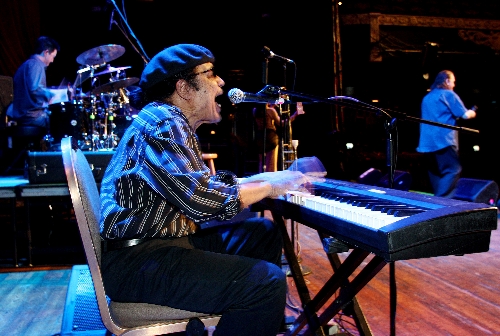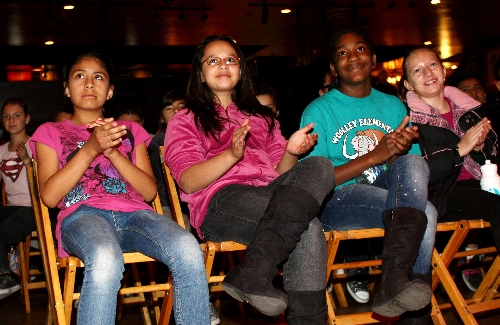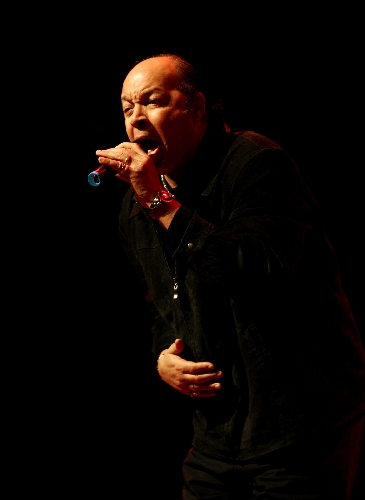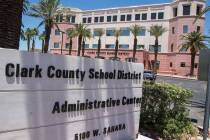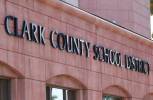Blues SchoolHouse uses music to teach schoolchildren America’s history
The kids walk --and run, and skip -- into the House of Blues at Mandalay Bay, 3950 Las Vegas Blvd. South, a place they've probably never been, on a field trip probably unlike any they've ever taken.
The sound of the band warming up behind the curtain is the first hint that this won't be a typical field trip. The second comes when Laura Clark, program manager for the International House of Blues Foundation Las Vegas, walks to the front of the stage to welcome them.
"We have so many people here today," Clark tells the kids, "there's no excuse for this quiet."
The 300 or so kids who pack the main floor and mezzanine of the House of Blues' music hall are fifth-graders from Clark County public schools. During the next 75 minutes or so, they'll learn about American history and culture via a music genre they'll find both new and familiar.
The blues.
The program is called Blues SchoolHouse and it's sponsored by the International House of Blues Foundation. According to Clark, Blues SchoolHouse was created in 1998 and made its debut in Las Vegas the following year.
In a "good year," between 9,000 and 10,000 Clark County schoolchildren will attend Blues SchoolHouse, she says, although "budget constraints" will whittle that down to between 6,000 and 7,000 this year.
The program is offered free of charge to public school pupils, while private school students and private groups are charged $5 per person.
"Occasionally we'll get senior groups that want to come in, like the Red Hat Society or senior centers," Clark adds. "And home school groups will utilize our program."
The goal of Blues SchoolHouse is to teach children about the evolution of the blues and demonstrate how the genre has been influenced by events in American history. That, Clark says, provides teachers with a way to connect Blues SchoolHouse to lessons in music, art, history, language arts and other subjects.
"We follow an American history timeline. We touch on key events in American history with an emphasis on African-American history," Clark adds.
During the show, lead vocalists and narrators Teddy Davis Jr. and MarQue Munday sing, dance and even do impressions (including Elvis Presley and Michael Jackson for Davis and Bessie Smith and Big Mama Thornton for Munday) in outlining the intertwined story of the blues and America.
The story of the blues, Davis tells his audience at the start of the program, is a story "about the strength of the human spirit."
The story begins with slavery and continues through emancipation, the Depression, the Great Migration and the civil rights moment, with Davis, Munday and members of the band performing snippets of songs by Dinah Washington, Duke Ellington, Muddy Waters, Fats Domino and other legends of the American songbook.
The schoolchildren are attentive and participate in demonstrations of such concepts as polyrhythm and call and response. They're happy to clap along as the songs play. But the material suddenly becomes first-hand familiar to them when Munday, donning a feather boa as Big Mama Thornton, belts out the original, bluesy version of "Hound Dog."
Then, when Davis follows by doing the same song in a slightly goofy impersonation of Elvis Presley, the young audience perks up, seeing a connection between the blues and songs they've heard themselves.
That, Davis says, is a lesson just as important: The blues, as he, Munday and the band demonstrate to the children throughout the program, have influenced all American music, including the music the kids listen to today.
The lesson seems to take. Andrea Wilson, 11, a fifth-grader at Woolley Elementary School, says she liked the program "for the music" and admits she didn't know what to expect from Blues SchoolHouse.
"I didn't know, because my teacher told me that a man was going to stand up there and talk," she says.
Classmate Devin McAlpine, 11, says the program was "really good," and that his favorite part was "the funny impression of Elvis."
Woolley fifth-grade teacher Richard Moffett says he has brought classes to Blues SchoolHouse "every year for the last seven years."
"I was introduced to it through a fifth-grade teacher years ago, and I actually just fell in love with the program," he says.
Blues SchoolHouse is "suitable for many different parts of the curriculum," he says, adding that middle school teachers are more apt to use it for music, while "our part is, of course, history."
For Camille Duskin, a volunteer who shepherds audience members and encourages them to participate, the best lessons of Blues SchoolHouse arise out of what she calls "that a-ha moment."
Those, Duskin says, come when "suddenly that child does this" -- she taps her foot -- "or claps along or starts to smile or stands up to dance."
Contact reporter John Przybys at jprzybys@reviewjournal.com or 702-383-0280.



